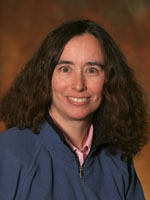
Susan N. Coppersmith
University of Wisconsin at Madison
The Movers and Shakers
The first Gordon Conference I attended was the 1983 Condensed Matter Physics Conference (then called Quantum Solids and Fluids). I was encouraged to apply by my thesis adviser, Daniel S. Fisher, who was an invited speaker. I was a graduate student at Cornell University, and I felt an enormous contrast between the atmospheres of GRC and the American Physical Society meeting the previous March, where I had felt quite lost among the thousands of attendees. At GRC everyone ate meals to-gether, socialized, and recreated together (I still vividly remember playing basketball badly in an extremely hot gym), and I felt much more integrated into the community.
I attended this conference again as a postdoc in 1986. Fisher was a conference cochair and invited me to give a talk, which not only was a great opportunity but also gave me exposure that helped in my job search. Like the 1983 conference, the 1986 conference gave an over-view of exciting developments in the field.
Management of the Condensed Matter Physics Conference was a bit challenging. Its great breadth provided an avenue to learn about the latest developments in the field; however, the result was that attendees of successive conferences were quite different. The conference chair needed to be proactive and to solicit adequate attendance diligently. The conference also did not have the usual succession of vice chair to chair, which led to communication problems with GRC headquarters. In the early 1990s a sequence of meetings had low attendance numbers. By the time I was elected chair of the 1995 conference, it was on probation and faced cancellation. Vice Chair Sidney Nagel and I spent a lot of time and energy with the GRC staff discussing strategies for developing a compelling scientific program and increasing attendance, and our conference was quite successful. The conference adopted the usual chair—vice chair succession, implemented a biennial schedule, and narrowed its concentration to soft condensed matter physics.
At about the same time the Correlated Electron Systems Conference started up, with its first meeting in 1996. I have attended both conferences, and they each have been quite successful over the last decade. The content of both has evolved and helped define the cutting edge of condensed matter physics.
The Condensed Matter Physics GRC faces issues that are typical of many subfields in the physical sciences, especially in contrast to the biological sciences. The total number of scientists working in the physical sciences is smaller than that of other fields, and many of these scientists work on a range of topics. During a period when my husband worked specifically in a well-defined area of bone research, my own work, for example, spanned various subfields, including complex fluids, condensed matter physics, glasses, granular materials, nonlinear science, quantum computing, strongly correlated electronic systems, and theoretical biology, many of which are covered by Gordon Conferences. For a researcher moving into a new subfield, Gordon Conferences are particularly valuable because they provide an efficient way to learn the latest developments, to meet the “movers and shakers,” and to have in-depth discussions. But because the community of attendees is constantly changing, chairs find it difficult to attract the audience, even for exciting scientific programs. This challenge is fitting for a conference of great value, and by facing the issues squarely, Gordon Conferences continue to help define the forefront of the physical sciences in the coming decades.